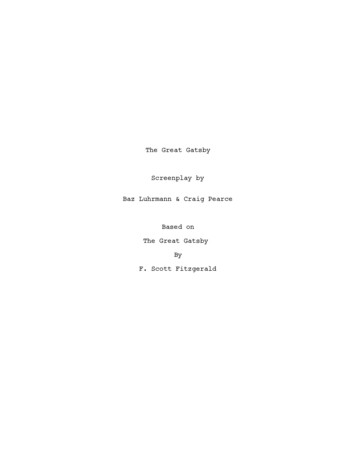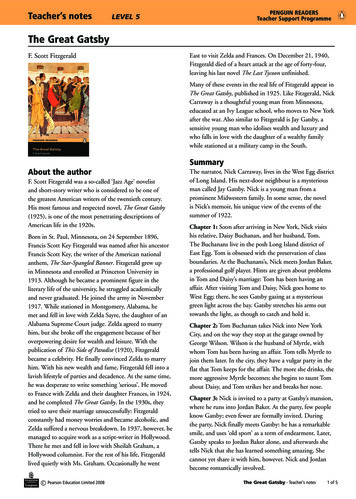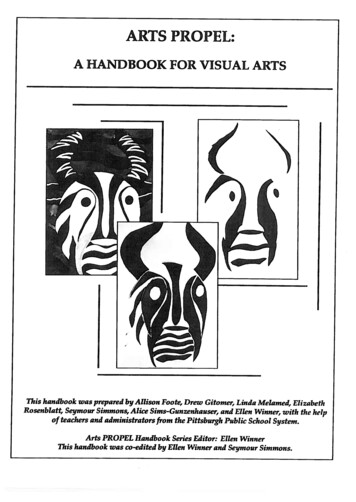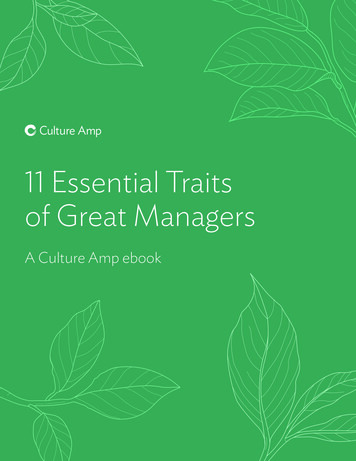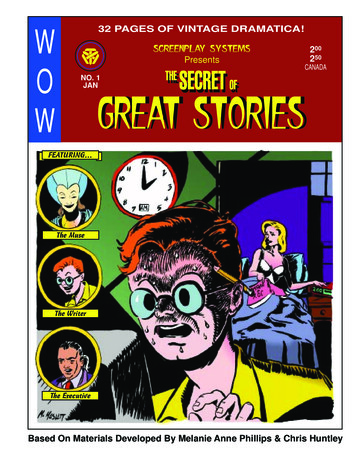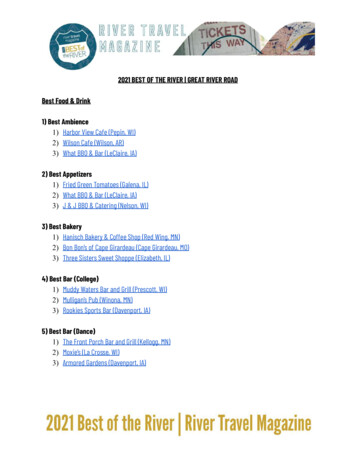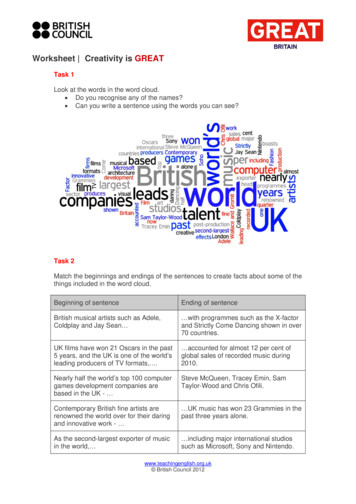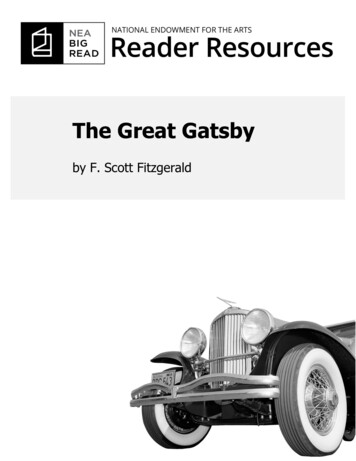
Transcription
The Great Gatsbyby F. Scott Fitzgerald1
Table of ContentsThe GreatGatsbyAbout the Book. 3About the Author . 4Historical and Literary Context . 5Other Works/Adaptations . 6Discussion Questions. 9Additional Resources . 10Credits . 11“Show me a hero andI will write you atragedy.”PrefaceThe Great Gatsby may be the most popular classic inmodern American fiction. Since its publication in 1925,Fitzgerald's masterpiece has become a touchstone forgenerations of readers and writers, many of whom reread itevery few years as a ritual of imaginative renewal. The storyof Jay Gatsby's desperate quest to win back his first lovereverberates with themes at once characteristically Americanand universally human, among them the importance ofhonesty, the temptations of wealth, and the struggle toescape the past. Though The Great Gatsby runs to fewerthan two hundred pages, there is no bigger read in Americanliterature.What is the NEA Big Read?A program of the National Endowment for the Arts, NEA BigRead broadens our understanding of our world, ourcommunities, and ourselves through the joy of sharing agood book. Managed by Arts Midwest, this initiative offersgrants to support innovative community reading programsdesigned around a single book.A great book combines enrichment with enchantment. Itawakens our imagination and enlarges our humanity. It canoffer harrowing insights that somehow console and comfortus. Whether you’re a regular reader already or making upfor lost time, thank you for joining the NEA Big Read.NEA Big ReadThe National Endowment for the Arts2
About the BookIntroduction tothe BookF. Scott Fitzgerald's 1925 novelThe Great Gatsby is a tragiclove story, a mystery, and asocial commentary onAmerican life. Although it wasnot a commercial success forFitzgerald during his lifetime,this lyrical novel has becomean acclaimed masterpiece readand taught throughout theworld.Unfolding in nine concisechapters, The Great Gatsby concerns the wasteful lives offour wealthy characters as observed by their acquaintance,narrator Nick Carraway. Like Fitzgerald himself, Nick is fromMinnesota, attended an Ivy League university, served in theU.S. Army during World War I, moved to New York after thewar, and questions—even while participating in—highsociety.Having left the Midwest to work in the bond business in thesummer of 1922, Nick settles in West Egg, Long Island,among the nouveau riche epitomized by his next-doorneighbor Jay Gatsby. A mysterious man of thirty, Gatsby isthe subject of endless fascination to the guests at his lavishall-night parties. He is rumored to be a hero of the GreatWar. Others say he served as a German spy. Gatsby claimsto have attended Oxford University, but the evidence issuspect. As Nick learns more about Gatsby, every detailabout him seems questionable, except his love for thecharming Daisy Buchanan.Jay Gatsby's decadent parties are thrown with one goal: toattract Daisy, who lives across the bay in the morefashionable East Egg. From the lawn of his sprawlingmansion, Gatsby can see the green light glowing on herdock, which becomes a symbol in the novel of anunreachable treasure, the "future that year by year recedesbefore us."decency and self-indulgence. In the novel's conclusion, thecharacters collide, leaving human wreckage in their wake.Major Characters in the BookNick CarrawayNick, a young Midwesterner educated at Yale, is the novel'snarrator. When he moves to the West Egg area of LongIsland, he joins the lavish social world of Tom, Jordan,Gatsby, and his cousin Daisy.Jay GatsbyThe handsome, mysterious Gatsby, who lives in a mansionnext door to Nick's cottage, is known for his lavish parties.Nick, whom he trusts, gradually learns about Gatsby's pastand his love for Daisy.Daisy BuchananBeautiful, charming, and spoiled, Daisy is the object ofGatsby's love. Her caprice and materialism lead her to marryTom Buchanan.Tom BuchananFrom an enormously wealthy Chicago family, Tom is aformer Yale football star who sees himself at the top of anexclusive social hierarchy. He is conceited, violent, racist,and unfaithful.Jordan BakerDaisy's friend Jordan epitomizes the modern woman of the1920s. A liberated, competitive golfer, she is firmlyestablished in high society. She both attracts and repels Nickas a romantic interest.George WilsonThe owner of an auto garage at the edge of the valley ofashes, George finds his only happiness through his faithlesswife, Myrtle.Myrtle WilsonMyrtle dreams of belonging to a higher social class thanGeorge can offer. Vivacious and sensual, she hopes heradulterous affair will lead to a life of glamour.Though Daisy is a married socialite and a mother, Gatsbystill worships her as his "golden girl." They first met whenshe was a young lady from an affluent family and he was aworking-class military officer. Daisy pledged to wait for hisreturn from the war. Instead she married Tom Buchanan, awealthy classmate of Nick's. Having obtained a greatfortune, Gatsby sets out to win her back again.A profound indictment of class privilege in the Jazz Age andbeyond, The Great Gatsby explores the conflict betweenNEA Big ReadThe National Endowment for the Arts3
About the AuthorF. Scott Fitzgerald,1896–1940:Between LaurelsSeptember 24, 1896: Into afamily that traces its ancestryto the author of "The StarSpangled Banner," FrancisScott Key Fitzgerald is born inhis parents' house on LaurelAvenue in St. Paul, Minnesota.The Way UpAlthough Fitzgerald's fatherwent bankrupt, Fitzgerald stillF. Scott Fitzgerald, c. 1925(American Stock/Gettyplayed with the rich kids intown. This paradox would later Images)inform his fiction. His awareness of his situation sharpenedduring his years at Princeton, where he studied from 1913 to1917 until he accepted a commission from the U.S. Army. Henever saw combat. During World War I, Fitzgerald wasstationed near Montgomery, Alabama, where he beganrevising what became his first novel, This Side of Paradise(1920). There he also met the love of his life, Zelda Sayre,the charming, mercurial daughter of a judge. Fitzgerald'searly literary successes soon made him and Zelda celebritiesof the Jazz Age—a term he coined. During the 1920s, Zeldaserved as his editor, confidante, and rival. Their appetite forexcess made them notorious in an age when excess was thenorm. The Fitzgeralds moved to France in 1924 with theiryoung daughter, Frances (nicknamed Scottie), where theyfell among a group of American expatriate artists whom thewriter Gertrude Stein christened the Lost Generation. In1925 publisher Charles Scribner's Sons came out withFitzgerald's The Great Gatsby, which has become his mostenduring work.NEA Big ReadThe National Endowment for the ArtsThe Way DownFitzgerald would not publish another novel for nine years. In1932, Zelda suffered a breakdown from which she neverfully recovered. She spent most of her remaining days inmental institutions. Fitzgerald sold stories to The SaturdayEvening Post and Esquire to keep financially afloat. Implicitlyacknowledging his wife's mental illness and his ownalcoholism, he drew on their life abroad in the novel TenderIs the Night (1934). Fitzgerald relocated to Hollywood in1937 to write screenplays. His sole screen credit from thisperiod is for the film Three Comrades (1938). It joins hisother script credit, Pusher-in-the-Face (1929), from anearlier California stint. Eventually Fitzgerald began sustainedwork on his novel The Last Tycoon (1941). Tragically, hisend came before the book's did. Several chapters shy offinishing, Fitzgerald died of a heart attack in the apartmentof his Hollywood companion, columnist Sheilah Graham,while eating a chocolate bar and listening to Beethoven'sEroica symphony.December 21, 1940: Fitzgerald dies of a heart attack. Hisfinal address: 1403 N. Laurel Avenue, Los Angeles,California.4
Historical and Literary ContextThe Roaring Twenties19251920 The 18th Amendment, establishing Prohibition,becomes law. The 19th Amendment passes, giving 26 millionwomen the right to vote. Warren G. Harding is elected president. Charles Scribner's Sons publishes The Great Gatsby. First issue of the New Yorker goes to press. After John Scopes is charged with teaching fromDarwin's Origin of Species, Clarence Darrow takes hiscase.19261921 Charlie Chaplin stars in The Kid. Coco Chanel introduces Chanel No. 5. The value of bootlegging in the U.S. estimated at 3.6billion. Rorschach inkblot tests first used. Benny Goodman records his first solo, "He's the LastWord," with the Ben Pollack Band. "Shoeless" Joe Jackson and others banned frombaseball in wake of the "Black Sox" scandal. Henry Ford institutes the 5-day workweek and 8-hourworkday.19221927 James Joyce's Ulysses published. T.S. Eliot's The Waste Land published. First issue of Reader's Digest published. Louis Armstrong leaves New Orleans for Chicago toplay with King Oliver. Dance marathon craze begins.1923 The Jazz Singer opens as the first talking motionpicture. Charles Lindbergh lands his Spirit of St. Louis in Parisafter the first transatlantic flight. Ford introduces the Model A. Duke Ellington opens a four-year residency at theCotton Club in New York City.1928 First transcontinental nonstop flight takes off fromNew York and lands in San Diego. Jelly Roll Morton makes his first Paramount recordingsin Chicago. President Harding dies; Calvin Coolidge takes oath ofoffice.1924 Walt Disney makes his first Mickey Mouse silent short,Plane Crazy, and succeeds with his second one,Steamboat Willie, which was synchronized with sound. Amelia Earhart becomes the first woman to make atransatlantic flight. Herbert Hoover is elected president.1929 George Gershwin premieres Rhapsody in Blue. J. Edgar Hoover appointed director of the Bureau ofInvestigation, later named the FBI. The ten-millionth Model T rolls off the Ford assemblyline. Colleen Moore plays the title role in the film ThePerfect Flapper.NEA Big ReadThe National Endowment for the Arts March 26: The New York Stock Exchange hits a recordhigh, with 8.2 million shares traded. The Gerber Co. invents canned baby food. Ernest Hemingway's A Farewell to Arms is published. October 29: On Black Tuesday, the stock marketcrashes.5
Other Works/AdaptationsFitzgerald and the Jazz AgeFitzgerald and His Other WorksMost young American veterans of the First World War camehome changed by two revelations. One was the horror oftrench warfare; the other was their exposure to life inLondon and Paris, where artists and writers celebrated sheersurvival with decadent verve.Zelda Sayre refused to marry Fitzgerald unless he couldprovide for her. Following his honorable discharge from theArmy in 1919, he moved to New York alone to revise hismanuscript of This Side of Paradise. Twice rejected by thepublisher Charles Scribner's Sons, the novel amounted to athinly veiled autobiography of Fitzgerald's Princeton years.When Scribner finally published This Side of Paradise in1920, Fitzgerald won not only literary fame and temporaryfinancial security, but also the hand of his beloved Zelda.Raised by Puritan-minded parents to succeed first at IvyLeague universities and then in business, masses of youngmen and their wives-to-be returned at least mildly shellshocked by their conflicting experiences.Despite serving stateside during the war, F. Scott Fitzgeraldnevertheless wrote of this disenchantment and itsconsequences in his greatest works. The nihilism of this LostGeneration is evident from This Side of Paradise's concludingpage, when Fitzgerald said they had "grown up to find allGods dead, all wars fought, all faiths in man shaken."Americans had two strong and opposite reactions to thisstate of affairs: The older generation pushed for new laws tocontrol social outbursts, and the new generation rejectedthose laws, especially the Eighteenth Amendment, whichforbade the manufacture and sale of alcohol. ManyAmericans turned to bootleggers, who illegally either servedalcohol smuggled from abroad or distilled their own. In TheGreat Gatsby, the title character's party guests oftenattribute his extraordinary wealth to bootlegging and otherillicit activities.Introducing the seventieth anniversary edition of The GreatGatsby, Fitzgerald scholar Matthew J. Bruccoli wrote that theGreat War "triggered disillusionment, moral reevaluation,social experimentation, and hedonism. Although Fitzgeraldjoined the parties and chronicled them, he wrote injudgment."Not only was he the most famous writer of the 1920s,Fitzgerald also coined the term Jazz Age, which denoted anera of ragtime, jazz, stylish automobiles, and uninhibitedyoung women with bobbed hair and short skirts.Often called the Roaring Twenties, the postwar decadesometimes appears as one long flamboyant party, where theurban rich danced the Charleston and the foxtrot until 2 a.m.In fact, one might just as convincingly describe it as a periodof individual possibility and lofty aspirations to serve thegreater good. In his 1931 essay "Echoes of the Jazz Age,"Fitzgerald wrote, "It was an age of miracles, it was an age ofart, it was an age of excess, and it was an age of satire."NEA Big ReadThe National Endowment for the ArtsThis initial success established a pattern: After every novel,Scribner published a collection of new Fitzgerald shortstories. During his lifetime, Fitzgerald was best known as theauthor of more than 150 stories, originally published in suchmagazines as The Saturday Evening Post, McCall's, Redbook,and Esquire. The collections—Flappers and Philosophers(1920), Tales of the Jazz Age (1922), All the Sad Young Men(1926), and Taps at Reveille (1935)—include such frequentlyanthologized pieces as "The Diamond as Big as the Ritz,""Babylon Revisited," and "Bernice Bobs Her Hair."In his lifetime, Fitzgerald earned more money from hisstories than from all his novels combined. His first Post storyin 1920 sold for 400; by 1928, some were bringing in 3,500 apiece.These stories provided a way for Fitzgerald to test themesand situations that he would later develop in his novels. Forexample, literary critics identify four stories from All the SadYoung Men—"Absolution," "Winter Dreams," "The SensibleThing," and "The Rich Boy"—as the "Gatsby-cluster," sincehe stripped and reused passages from them for his 1925masterpiece.High living in Europe and low sales for Gatsby silencedFitzgerald as a novelist for nine years, until he publishedTender Is the Night in 1934. The novel records the marriageof psychologist Dick Diver and his patient Nicole Warren. Aswith the emotionally ravaged Anthony and Gloria Patch fromhis 1922 novel The Beautiful and The Damned, readers ofteninterpret Dick and Nicole as alter egos for their author andhis wife.Fitzgerald's final works deal comically and tragically withHollywood. His college friend and literary editor, EdmundWilson, edited his unfinished novel The Last Tycoon forpublication in 1941. Its hero, Monroe Stahr, is partly basedon Irving Thalberg, MGM's "boy wonder" producer.Fitzgerald's seventeen Pat Hobby stories, written for Esquire,chronicle their hapless hero's misadventures as ascreenwriter. Scribner published a collection of themposthumously in 1962.6
Other posthumous collections include The Crack-Up (1945),The Basil and Josephine Stories (1973), and The ShortStories of F. Scott Fitzgerald (1989). These and the otherbooks mentioned here demonstrate how much more there isto Fitzgerald than just one book, however great.Works by F. Scott Fitzgerald This Side of Paradise, 1920 Flappers and Philosophers, 1920 The Beautiful and the Damned, 1922 Tales of the Jazz Age, 1922 The Vegetable, 1923 The Great Gatsby, 1925 All the Sad Young Men, 1926 Tender is the Night, 1934 Taps at Reveille, 1935Fitzgerald's only publisher during his lifetime was CharlesScribner's Sons.Fitzgerald at the MoviesFitzgerald's masterpiece has not had the best of luck at themovies. Only the 1974 incarnation, starring Robert Redfordas Jay Gatsby—and written by Francis Ford Coppola afterTruman Capote failed to deliver—even approaches thepoetry of the original. However, despite Redford's artfulperformance, Fitzgerald scholar Matthew J. Bruccoli prefersAlan Ladd's 1949 interpretation of the role, finding Redfordtoo intelligent to capture Gatsby's naiveté.Fitzgerald's other fiction has fared better on screen. The bestand most ambitious adaptation of his work may still be theBBC's award-winning Tender Is the Night (1985), scripted byDennis Potter (Pennies From Heaven) and starring PeterStrauss and Mary Steenburgen as Dick and Nicole Diver.The Fitzgerald story "Teamed With Genius" became a wittyTV movie written and directed by Robert Thompson(Northern Exposure), featuring a strong lead performancefrom Christopher Lloyd as the author's comic screenwriteralter ego, Pat Hobby. Joan Micklin Silver (Hester Street)wrote and directed an acclaimed TV version of the story"Bernice Bobs Her Hair," starring Shelley Duvall. Even Nobellaureate Harold Pinter's somber feature adaptation of TheLast Tycoon (1976) for director Elia Kazan has its defenders,and Robert De Niro's delivery of Monroe Stahr's immortalspeech about the movies is a showstopper.Posthumously Published The Love of the Last Tycoon: A Western. New York:Scribner, 1941. (Originally published under editorEdmund Wilson's title, The Last Tycoon.) The Crack-Up. Ed. Edmund Wilson. New York: NewDirections, 1945. The Basil and Josephine Stories. New York:Scribners, 1973. The Short Stories of F. Scott Fitzgerald. New York:Scribners, 1989.NEA Big ReadThe National Endowment for the Arts7
Which of the following adaptationsdeserved the green light? The Great Gatsby (2013) Directed by BazLuhrmann. Written by Baz Lurhmann and CraigPearce. Starring Leonardo DiCaprio as Gatsby,Carey Mulligan as Daisy, Joel Edgerton as Tom, andTobey Maguire as Nick. The Great Gatsby (2000) (TV) Directed by RobertMarkowitz. Written by John McLaughlin. StarringToby Stephens as Gatsby, Mira Sorvino as Daisy,Martin Donovan as Tom, and Paul Rudd as Nick. The Great Gatsby (1974) Directed by Jack Clayton.Written by Francis Ford Coppola. Starring RobertRedford as Gatsby, Mia Farrow as Daisy, Bruce Dernas Tom, Karen Black as Myrtle, Scott Wilson asWilson, Sam Waterston as Nick, Lois Chiles asJordan, and Howard Da Silva as Wolfsheim. The Great Gatsby (1949) Directed by Elliott Nugent.Written by Cyril Hume and Richard Maibaum.Starring Alan Ladd as Gatsby, Betty Field as Daisy,Macdonald Carey as Nick, Ruth Hussey as Jordan,Barry Sullivan as Tom, Howard Da Silva as Wilson,and Shelley Winters as Myrtle. The Great Gatsby (1926) Directed by HerbertBrenon. Written by Becky Gardiner from anadaptation by Elizabeth Meehan. Starring WarnerBaxter as Gatsby, Lois Wilson as Daisy, NeilHamilton as Nick, Georgia Hale as Myrtle, andWilliam Powell as Wilson.NEA Big ReadThe National Endowment for the Arts8
Discussion Questions1.The novel's action occurs in 1922 between June andSeptember. How does Nick's nonchronologicalnarration shape your response to the eventssurrounding the mystery of Jay Gatsby?2.Nick believes he is an honest, nonjudgementalnarrator. Do you agree?3.Gatsby believes that the past can be repeated. Is heright?4.Why does Daisy sob into the "thick folds" ofGatsby's beautiful shirts?5.What do the faded eyes of Doctor T. J. Eckleburgsymbolize? Is there a connection between thisbillboard and the green light at the end of Daisy'sdock?6.Perhaps the novel's climax occurs when Gatsbyconfronts Tom in New York. Did Daisy's ultimatechoice surprise you? Is it consistent with hercharacter?7.Do you agree with Nick's final assertion that Gatsbyis "worth the whole damn bunch put together"?Why or why not?8.
alcoholism, he drew on their life abroad in the novel Tender Is the Night(1934). Fitzgerald relocated to Hollywood in 1937 to write screenplays. His sole screen credit from this period is for the film Three Comrades (1938). It joins his other script credit, Pusher-in-the-Face (1929), from an earlier California stint.File Size: 581KBPage Count: 11Explore furtherThe Great Gatsby - Winston-Salem/Forsyth County Schoolswww.wsfcs.k12.nc.usThe Great Gatsby - Planet eBookwww.planetebook.comThe Great Gatsby annotated.pdf - Google Searchdocs.google.comTHE GREAT GATSBYwww.ntschools.org(PDF) ANALYSIS Fitzgerald, F Scott The Great Gatsby (1925 .www.academia.eduRecommended to
